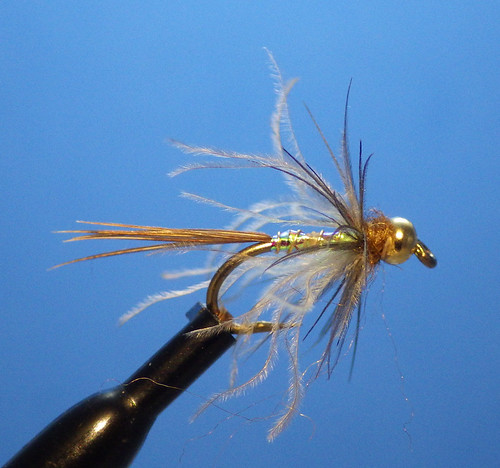Page 1 of 1
Callibaetis Soft Hackle emerger
Posted: Sat Mar 18, 2017 4:40 pm
by Roadkill
Here is another NWFT Expo fly courtesy of Hal Gordon's demo. My clone for my fly box is:
Hook- Mustad 3906 #12 with 7/64 brass bead
Thread- Tan Monocord
Tail- Pheasant Tail fibers
Body- Opal Mylar
Rib- Small Gold Ultra Wire
Collar- Natural CDC
Hackle- Starling
Head- Brown Antron
 IMGP4140
IMGP4140 by
William Lovelace, on Flickr
Re: Callibaetis Soft Hackle emerger
Posted: Sun Mar 19, 2017 3:33 am
by letumgo
Oooo...I would love to see how that looks underwater. I bet the CDC forms a nice bubble shroud around the reflective Mylar body. What a nice combo.
Great stuff Bill. Thanks for sharing.
Re: Callibaetis Soft Hackle emerger
Posted: Sun Mar 19, 2017 7:35 am
by tie2fish
I'm betting that looks delicious underwater to the eye of a fish. But why a bead on an emerger? Just curious ...
Re: Callibaetis Soft Hackle emerger
Posted: Sun Mar 19, 2017 7:44 am
by letumgo
chuckle
Even a bead head fly becomes an emerged, at the tail end of a drift. (wink/smile)
Re: Callibaetis Soft Hackle emerger
Posted: Sun Mar 19, 2017 10:19 am
by zen leecher
I'd be interested in hearing how this works in Oregon for you. Up here ours are a slightly different coloration, at least the freshly hatched duns are.
Re: Callibaetis Soft Hackle emerger
Posted: Sun Mar 19, 2017 10:42 am
by tie2fish
letumgo wrote:chuckle
Even a bead head fly becomes an emerged, at the tail end of a drift. (wink/smile)
Good point, Ray ... cuts down on the mending required.
Re: Callibaetis Soft Hackle emerger
Posted: Sun Mar 19, 2017 11:32 am
by Roadkill
I didn't ask Hal about the bead. But I know I tie and fish many flies in different weights depending on water conditions or technique. Callibaetis in Western lakes may be found about 15' down and anywhere in between the weeds and the surface.
Bill,
Two thoughts come to mind about the bead.

In our lakes if you fish a long leader and countdown method to find the feeding level of fish when there is no surface activity, it will be awhile before an unweighted CDC fly will sink down to the feeding zone. As Marv Taylor taught about float tube fishing methods "Would you rather spend your time counting or catching fish?".

You could also just fish with unweighted flies and weighted lines and shorter leaders. It is my understanding that prior to emergence at the surface Callibaetis nymphs also zigzag up and down in the water column. Weighted flies can help mimic that kind of swimming activity on a retrieve.
Besides fishing a dead drift and/or swing in a river if you are using the Leisenring lift and a cast up stream to get down to a fish in a feeding lane, the weighted fly may be needed to target that sighted fish.
Zen,
Based on how well my Lightning Bug Soft Hackle has worked for me in many waters and Hal's 50+ years of experience, I think this will be a keeper in my vests. If I were fishing the duns here I will probably be using a muskrat body or something mixed showing a tan to olive cast. No doubt I will be testing this fly with another SH and/or my Callibaetis Parachute Dry just up the line.
Re: Callibaetis Soft Hackle emerger
Posted: Sun Mar 19, 2017 2:28 pm
by William Anderson
Bill, you've put together a compelling little pattern. I've seen these constructions that end up looking much fuller. You've managed a nice, sparse over all impression for a little fly sporting 7 materials. Well done.
I like your description of what you guys are doing out on your lakes.
w
Re: Callibaetis Soft Hackle emerger
Posted: Wed Mar 22, 2017 11:41 am
by zen leecher
Roadkill wrote:I didn't ask Hal about the bead. But I know I tie and fish many flies in different weights depending on water conditions or technique. Callibaetis in Western lakes may be found about 15' down and anywhere in between the weeds and the surface.
Bill,
Two thoughts come to mind about the bead.

In our lakes if you fish a long leader and countdown method to find the feeding level of fish when there is no surface activity, it will be awhile before an unweighted CDC fly will sink down to the feeding zone. As Marv Taylor taught about float tube fishing methods "Would you rather spend your time counting or catching fish?".

You could also just fish with unweighted flies and weighted lines and shorter leaders. It is my understanding that prior to emergence at the surface Callibaetis nymphs also zigzag up and down in the water column. Weighted flies can help mimic that kind of swimming activity on a retrieve.
Besides fishing a dead drift and/or swing in a river if you are using the Leisenring lift and a cast up stream to get down to a fish in a feeding lane, the weighted fly may be needed to target that sighted fish.
Zen,
Based on how well my Lightning Bug Soft Hackle has worked for me in many waters and Hal's 50+ years of experience, I think this will be a keeper in my vests. If I were fishing the duns here I will probably be using a muskrat body or something mixed showing a tan to olive cast. No doubt I will be testing this fly with another SH and/or my Callibaetis Parachute Dry just up the line.
I eagerly await your results.
 IMGP4140 by William Lovelace, on Flickr
IMGP4140 by William Lovelace, on Flickr IMGP4140 by William Lovelace, on Flickr
IMGP4140 by William Lovelace, on Flickr